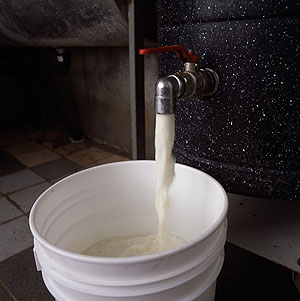Healthy Calf Conference
Follow to stay up-to-date on all Healthy Calf Conference updates. Speaker announcements, sponsorship information, registration announcements, and more.
Deciding which milk replacer to use can be very challenging. Below are a few key things you should be aware of when making this decision, as not all milk replacers are created equal.
The primary nutrients of milk replacer are protein, fat (energy), carbohydrates, vitamins and minerals. When evaluating which milk replacer to use on farm, consider:
Less expensive products are generally not all-milk protein milk replacers.

Milk replacer should contain approximately 20–22 per cent protein. Calves less than three weeks of age should be on an all–milk protein milk replacer. Non–milk sources can decrease available protein to the calf and result in diarrhea. Milk replacers of non–milk sources are fine for calves over three weeks old.
A common milk source of protein for milk replacer is whey. Whey is a by–product of cheese making. On the ingredient list, look for dried whey, whey product or whey protein concentrate (WPC). The difference in these products is the amount of lactose and mineral removed from the dried whey. For example, dried whey contains 12 per cent protein and WPC contains 80 per cent protein.
There is also a significant variation in digestibility of whey protein. Factors affecting the digestibility are the cheese type, drying temperatures and handling procedures for the whey protein. All whey goes through strict quality testing for bacterial growth, browning reaction, mineral and salt content and protein degradation. Options for non–milk sources include soy protein, soy flour, wheat proteins, potato and animal plasma protein. Soy protein has low digestibility and amino acid content. It can cause an allergic reaction in the gut tissue, decrease available protein to the calf and result in diarrhea. This source of protein is best used in calves over three weeks of age.
Soy flour is not a good choice for milk replacer, as it can decrease available protein to the calf and result in diarrhea. It too should be used in calves over three weeks of age.
Hydrolyzed wheat gluten protein is a high quality, economical protein source, manufactured from wheat flour by separating the gluten protein from wheat starch. It is difficult for calves under three weeks’ of age to digest, but more appropriate for older animals. Hydrolyzed wheat gluten is ideally suited for incorporation into calf milk replacers. It is low in fiber and ash, and contains a much higher percentage of protein compared to whey protein concentrate (80 per cent protein vs. 34 per cent protein). Digestibility of hydrolyzed wheat gluten dry matter, organic matter and crude protein is very high, estimated at 95 per cent. It is also free from anti–nutritional factors such as those common to soy proteins that are known to reduce animal performance.
Potato protein isolates have had the carbohydrate fraction (fibre) removed through special processing. This also removes the allergens, inhibitors and other anti–nutritional factors usually associated with plant proteins. They are low in fibre and lower in cost per pound of protein than milk proteins, making them a good choice for milk replacer.
Animal Plasma Protein is a unique protein source that contains active albumin and globulin proteins. It has an amino acid profile and nutritive value comparable to non–fat dried (skim) milk and casein. Animal plasma is obtained by centrifuging whole blood into its major components, plasma and blood cells. The two main types of animal plasma are bovine (ruminant) and porcine (swine). It is rather expensive, though, and consumers are increasingly worried about this type of protein source since BSE was discovered in Canada.
Energy is the level of fat in the milk replacer. The fat content of dry whole milk is 30 per cent. Milk replacer should contain 10 – 25 per cent crude fat. Calves less than two weeks old do not digest non–milk fats as well as milk fats, so milk replacers high in milk fat lowers the risk of diarrhea. Fats and oils go through quality testing for color, melting point, odour, and fatty acid profile. Common fats used are tallow, lard and coconut oil.
The amount of fibre in a product indicates how much plant protein it contains. The more added fibre, the higher the level of plant protein. Diets of calves under three weeks of age should contain less than half a per cent of crude fiber.
Source: Nutrient Requirements of Dairy Cattle. Seventh Revised Edition. National Research Council, 2001.
Ca: 1.0%,
P: 0.7%,
Vitamin A: 9,000 IU/kg,
Vitamin D: 600 IU/kg,
Vitamin E: 50 IU/kg
References:
Douglas f. Waterman Ph.D., Jenny Mills, MS 2007. Evaluating Milk Replacer Quality. Professional Dairy Heifer Growers Association, Pre-Conference Calf Seminar Robert E. James, Virginia Cooperative Extension, 2005, There are no free rides
Links
Merricks Milk Replacer Raw Material Guide
Calf Note on Milk Replacer Ingredient and Labels
A Guide to Calf Milk Replacers: Types, Use and Quality
Milk Replacer versus Whole Milk: Effects on Calf Performance
Follow to stay up-to-date on all Healthy Calf Conference updates. Speaker announcements, sponsorship information, registration announcements, and more.
The Codes of Practice are nationally developed guidelines for the care and handling of farm animals. They serve as our national understanding of animal care requirements and recommended practices.